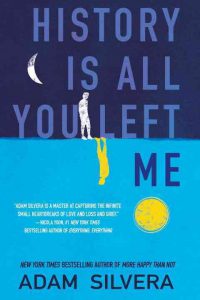 Set in Manhattan, New York, with scenes from Santa Monica, California, History Is All You Left Me by Adam Silvera is a deeply unsettling but important book about the total nightmare of life after losing a loved one. Although th
Set in Manhattan, New York, with scenes from Santa Monica, California, History Is All You Left Me by Adam Silvera is a deeply unsettling but important book about the total nightmare of life after losing a loved one. Although th
e book features more references to sex than some readers might find necessary, the book captures how love and heartbreak can turn someone crazy and suspicious and how the death of a loved one can make us “the worst kind of alive” (139), a life after death zombie without a brain, heart, light, or direction.
Griffin Jennings, a seventeen-year-old with a fixation for even numbers and with distracting compulsions that limit his life, loves Theo McIntyre, a “know-it-all who loves cartography, puzzles, video animation, and finding out what makes humans tick” (4). Curious, imaginative, and possessing a mind that runs in overdrive, Theo manages suffering by inventing alternate universes and by always asking the question: What if? He plans to bring these universes to life by enrolling in the animation program at Santa Monica College.
While away at school, Theo meets Jackson Wright, and a relationship develops, leaving Griffin to wonder about their endgame potential. But Theo dies, despite his promise, “I’ll never die” (2), leaving Jackson without a boyfriend and Griffin to grieve his favorite person. Because we keep lost loved ones near through history, history is all the survivors have left. Griffin is so steeped in grief that he obsesses about Theo, constantly talking to his spirit, because he doesn’t know what will be left for him “if love and grief can’t bring [Theo] back to life” (217) and because he doesn’t know how to be alive in a universe where he can’t talk to Theo. With a tremendous support system that includes squad member Wade, Griffin gradually comes to realize that “love isn’t this ultimate power that can make [a person] feel unbeatable and all-conquering . . . . Love is the hugest liar in this universe” (261).
Silvera tells the story with both poignancy and humor, coining terms like “good weird” different, capturing the awkwardness of buying condoms, and writing with a style predisposed to lists—perhaps as a way to remain true to Griffin’s OCD tendencies. In chapters that oscillate between the past and present, Silvera accurately describes the pain of death as a wound that never closes. Despite time, “the pain remains, always piercing, always burning, always suffocating, always bleeding” (113). Through Silvera’s characters, readers learn that a single moment can throw our lives off course and that loss can leave survivors feeling shattered and empty. The novel includes many other psychological truths:
- The shades of grief are as various as our ways of handling death
- “Silence is sometimes better than someone speaking before they’re ready” (194)
- Secrets can turn people into liars
- Honesty sometimes leads to happiness
- A person “who speaks the truth and looks out for everyone’s future” is “a capital p Person” (251)
- When we die, all of the knowledge we have downloaded into our brains is left behind as memories fo the ones we love.
In developing these truths, Silvera employs an extended metaphor with puzzle building and pieces fitting to describe life’s stories and how we are the authors capable of revision and rebuilding.
- Posted by Donna

